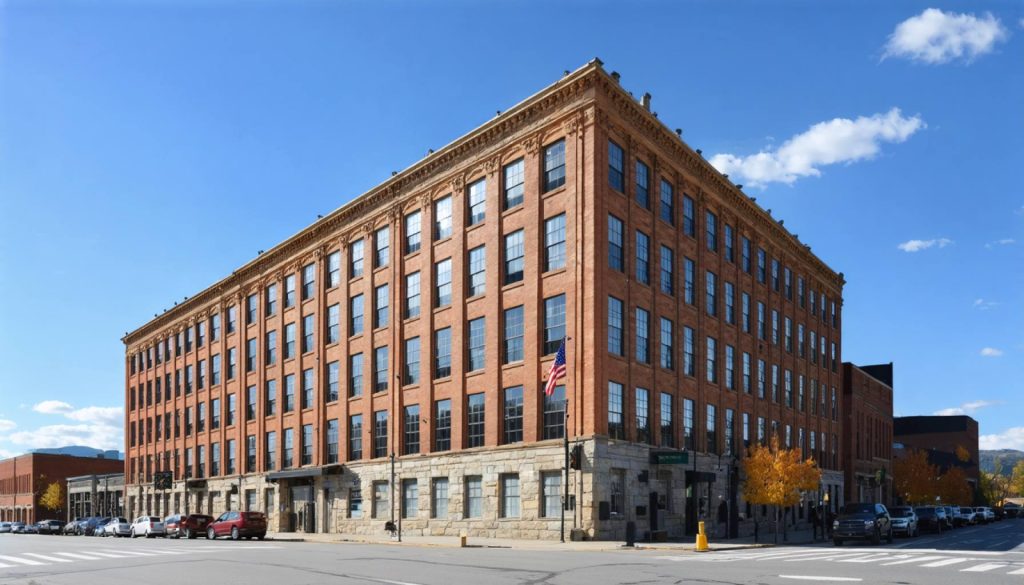
- BRIC transforms Springfield’s historic Park Street schoolhouse into an entrepreneurial hub, symbolizing a blend of history and innovation with a $7.2 million revitalization.
- Led by Vin Fusca, BRIC supports business incubation and housing, aiming to attract ambitious entrepreneurs from major cities despite economic challenges.
- The campus emphasizes social impact, focusing on long-term success over immediate exits, supported by a partnership with Google for digital skills training.
- BRIC fosters collaboration across Vermont, integrating STEAM programs for youth to build future-ready capabilities with initiatives like LEGO Robotics.
- Through the Cultivator program in Randolph, BRIC extends its influence, promoting rural revitalization and entrepreneurial growth.
- BRIC exemplifies Vermont’s transformation into a business-friendly environment, where innovation and history converge.
Amidst the green hills of Vermont, the Black River Innovation Campus (BRIC) is weaving a tapestry of history and innovation, transforming Springfield’s storied past schoolhouse into a cradle for the future of business. The echoes of bustling classrooms from 1895 are giving way to the hum of entrepreneurial ambition. Picture chimneys against the New England sky, framed by the gentle curve of old maple trees; this is where a new dawn rises for tech pioneers.
At the heart of this transformation stands BRIC, an embodiment of ingenuity—a $7.2 million metamorphosis reshaping the iconic Park Street schoolhouse. Here, dreams are no longer confined by brick and mortar; they scale the digital heights of cybersecurity, UI/UX design, and e-marketing. A once-static structure becomes a vibrant canvas for innovation. The historic woodwork cradles the aspirations of budding business minds as the grand staircase echoes their determined footsteps.
Leading this charge is Vin Fusca, whose vision transcends traditional entrepreneurship. He’s orchestrating a symphony of change, not only in renovations but in fostering a robust ecosystem that supports business incubation and housing. Yet the challenge looms large—balancing the idealistic dream of community with harsh economic realities. The audacity lies in believing that a network of 23 market-rate apartments can spring to life amidst financial uncertainties—each apartment a beacon for ambitious souls venturing from Boston, New York City, and beyond.
The steady rhythm of community and caring echoes throughout Vermont’s rolling valleys, and BRIC is in harmony with these values. With Fusca’s guidance, entrepreneurs are not just crafting businesses but etching social impact into their DNA. Gone are the days where the only win is the lucrative exit; now, the goal is longevity and meaningful impact.
BRIC’s partnership with tech giant Google amplifies its mission. Certified programs promise to arm local and national talents with digital prowess, threading together data analytics, e-marketing, and cybersecurity into the fabric of local businesses. Through a sprawling network, from The Hub CoWorks to Hula, Vermont is sculpting an environment where collaboration is king—a kingdom for those who dare to dream big, regardless of their zip code.
In parallel, BRIC proudly wears the mantle of preparing the young, investing in the architects of tomorrow. Local youth are diving into STEAM—science, technology, engineering, arts, math—through initiatives that convert curiosity into capability. LEGO Robotics kits and sold-out summer camps are forging a future where STEM isn’t just taught; it’s lived and breathed.
Beyond Springfield, BRIC’s influence extends like tendrils into Randolph through the Cultivator program. Here, Abbey Salomon, with her background rich in commercial acumen, ushers in an era of entrepreneurial enlightenment. With workshops open to Randolph’s hungry innovators, a phoenix rises from the idea ashes, fueled by vision and expertise. As Cultivator embraces new ideas and invigorates local economies, it stands as a model for rural revitalization.
BRIC is not just a place—it’s a movement. It revives the old to illuminate the new, crafting a narrative where history embraces the future. Underpinning this narrative is a single, daring message: Look to Vermont, where innovation thrives in its quaint towns and ancient hills, where collaboration breeds change. Small but mighty, Vermont is redefining business-friendly, and it’s time the world takes notice.
Unveiling Vermont’s Hidden Gem: How BRIC is Transforming Rural Innovation
Transforming Tradition: The Black River Innovation Campus (BRIC)
Vermont, known for its serene landscapes and rich history, is witnessing a transformation as the Black River Innovation Campus (BRIC) reinvents the historic Springfield schoolhouse into a modern hub of technology and entrepreneurship. Through this $7.2 million project, an old landmark morphs into a dynamic space for innovation in cybersecurity, UI/UX design, and e-marketing.
Key Features and Developments
1. Historic Transformation: The transition of a historical 1895 schoolhouse into a state-of-the-art innovation campus provides a unique blend of past and present. The renovation emphasizes preserving traditional woodwork while integrating modern facilities.
2. Leadership Vision: Vin Fusca’s vision drives BRIC, emphasizing community building alongside entrepreneurship. This includes creating 23 market-rate apartments targeting ambitious professionals moving from urban areas like Boston and New York City.
3. Tech Partnerships: BRIC’s collaboration with Google amplifies its educational programs, offering certified courses in data analytics, e-marketing, and cybersecurity to equip local and national talent with essential digital skills.
How-To Steps: Fostering Local Innovation
– Engage Local Communities: Encourage local youth and entrepreneurs through accessible workshops and programs focused on STEAM (Science, Technology, Engineering, Arts, Math) education.
– Leverage Strategic Partnerships: Build collaborations with tech giants like Google to ensure access to cutting-edge resources and expertise.
– Invest in Infrastructure: Develop spaces that blend historical preservation with modern technology to create welcoming environments for innovators.
Real-World Impact and Benefits
– Economic Revitalization: By fostering innovation and entrepreneurship, BRIC helps stimulate the local economy, creating jobs and attracting talent.
– Youth Engagement: Initiatives such as LEGO Robotics kits and popular summer camps engage young learners, fostering a future workforce adept in STEM fields.
– Rural Revitalization: Through its Cultivator program, BRIC extends its impact to neighboring areas like Randolph, providing workshops and resources to budding entrepreneurs.
Market Trends and Future Predictions
– Rise of Remote Workspaces: BRIC exemplifies an increasing trend where rural areas become appealing hubs for remote work, supported by technological innovation.
– Sustainability and Green Innovation: Moving forward, expect BRIC and similar initiatives to incorporate more sustainable practices, aligning with global trends toward environmental responsibility.
Actionable Tips for Entrepreneurs
1. Utilize Technology: Take advantage of BRIC’s partnerships and programs to gain new digital skills.
2. Network Intensively: Leverage the collaborative ecosystem at BRIC to connect with other innovators and potential partners.
3. Focus on Impact: Develop business ideas that incorporate social impact within their core mission.
Related Link
For more on fostering innovation and community growth in rural areas, visit the Vermont State Government website to explore resources and opportunities available.
BRIC stands as a testament to Vermont’s potential as a hub for innovation, blending history and modernity. By harnessing the power of community and technology, BRIC is setting a new standard for rural entrepreneurial ecosystems.



